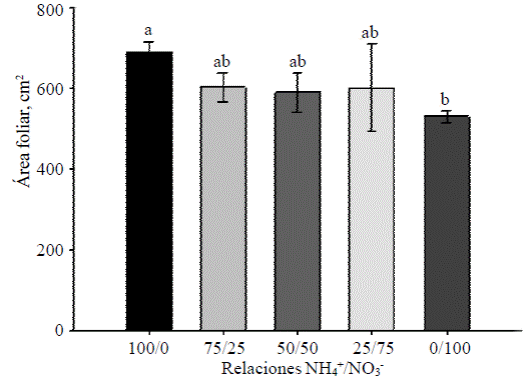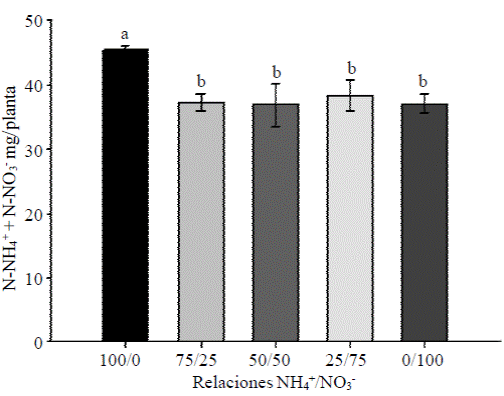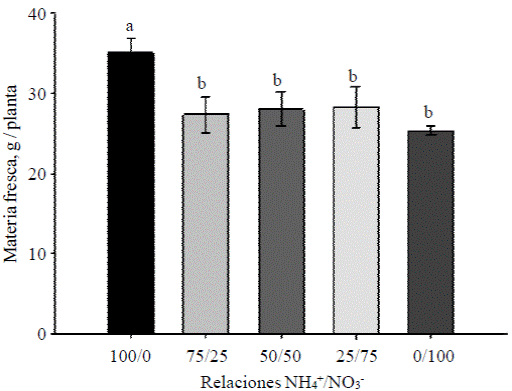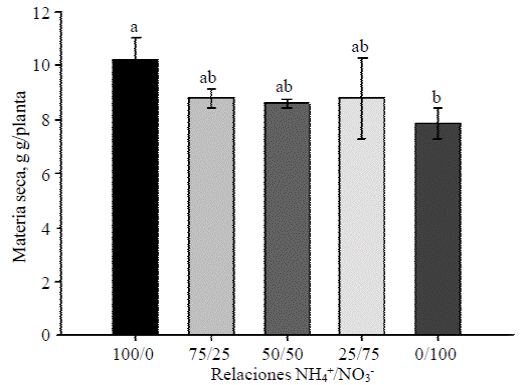Servicios Personalizados
Revista
Articulo
Indicadores
-
 Citado por SciELO
Citado por SciELO -
 Accesos
Accesos
Links relacionados
-
 Similares en
SciELO
Similares en
SciELO
Compartir
Revista mexicana de ciencias agrícolas
versión impresa ISSN 2007-0934
Rev. Mex. Cienc. Agríc vol.7 no.3 Texcoco abr./may. 2016
Articles
Agronomic and nutritional strawberry response to nutrient solutions with different ratio NH 4 + /NO 3 - in the vegetative stage
1 Colegio de Postgraduados Campus Montecillo-Edafología. C. P. 56230, Montecillo, Estado de México. (tcampos2@hotmail.com; alcantar@colpos.mx; cazagu@ colpos.mx).
The aim of this research was to determine the optimal ratio of NH4 +/NO3 - in the nutrient solution that favors the agronomic and nutritional behavior of strawberry cv. festival in an intensive production system during the vegetative- f lowering stage. The nutrient solutions (SN) were evaluated with different relationship NH4 +/NO3: 100/0, 75/25, 50/50, 25/75 and 0/100. At 108 days after initiated treatment (ddit) the following parameters were evaluated in strawberry plants leaf area (AF), content of fresh material (MF) and dry matter (DM) accumulation of N-NH4 y N-NO3 (AN) in the strawberry plants. In the vegetative-f lowering stage, the SN with a NH4 +/NO2 - ratio equal to 100/0 significantly increased AF, MF, MS and AN in strawberry plants cv. festival, compared with other treatments. Therefore, the addition of ammonium as sole N source for the production of strawberry during the vegetative stage is suggested.
Keywords: Fragaria x ananassa Duch.; accumulation of N; coir
El objetivo de la presente investigación fue conocer la relación óptima de NH4 +/NO3 - en la solución nutritiva que favorece el comportamiento agronómico y nutrimental de fresa cv. Festival en un sistema intensivo de producción durante la etapa vegetativa-floración. Se evaluaron soluciones nutritivas (SN) con diferente relación NH4 +/NO3: 100/0, 75/25, 50/50, 25/75 y 0/100. A los 108 días después de iniciados los tratamientos (ddit) se evaluaron los siguientes parámetros: área foliar (AF), contenido de materia fresca (MF) y materia seca (MS), acumulación de N-NH4 y N-NO3 (AN) en plantas de fresa. En la etapa vegetativa-floración, la SN con una relación N H4 +/ NO3 - igual a 100/0 incrementó significativamente AF, MF, MS y AN en plantas de fresa cv. Festival, en comparación con los demás tratamientos. Por lo tanto, se sugiere la adición de amonio como única fuente de N para la producción de fresa durante la etapa vegetativa.
Palabras clave: Fragaria x ananassa Duch.; acumulación de N; fibra de coco
Introduction
During intensive strawberry production there are two very important phenological stages, whose nutritional management define success in performance and fruit quality: vegetative-flowering and flowering-fruiting. For the first step is very important management and mainly nitrogen, the ammonium / nitrate ratio (Toktam et al., 2014). Excess NH4 + in this phase leads to exuberant production of sheets and this in turn generates an internal imbalance by competition ion NH4 + with K+, Ca+2 and Mg+2 (Ganmore and Kafkafi, 1985). The application of ammonium nitrogen makes them more susceptible to the strawberry plants to disease and insect invasion because its sap contains high levels of free amino acids, sugars and nitrogen that make them more attractive to plant pathogens (Cisneros and Godfrey, 2001; Ortega-Arenas et al., 2013).
The addition of nitrate in the nutrient solution can mitigate the inhibitory effect of ammonium in plant growth (Ota and Yamamoto, 1989), so in hydroponics is possible to use nitrogen sources based NO3 - and NH4 + (Gonzalez et al., 2009). The combination of both ions as nitrogen source improves vegetative growth, compared to when used separately (Hartman et al., 1986). Research conducted by Tabatabaei et al. (2006) have shown that strawberry plants 'Camarosa' and 'Selva' in soilless culture are more susceptible to ammonium nutrition. In addition, they found that the complete exclusion of NH4 + of the SN reduces growth and a relationship 25 NH4 +/75 NO3 - improves the development and performance of strawberry plants. Also, they noted that plants grown with 75% of NH4 + decreased the weight of MF, MS and AF, in counterpart with those who received 25% of NH4 +. The yield (length and weight of the fruit) increased by 38% and 84% in 'Camarosa' and 'Selva, respectively, when plants were grown with 25% NH4 + and 75% of NO3 -, compared with those who they received higher levels of ammonium.
Therefore, a combination of the two forms of N in an appropriate ratio (25 NH4 +: 75 NO3 -) is beneficial to plant growth, yield and quality of strawberries. In turn, Cardenas- Navarro et al. (2006) found that the formulation of different relationships NH4 +/NO3 - in the SN not affect the growth of the mother plant; however, the number of fruits is increased with increasing ammonium; Moreover, the number of daughter plants not affected by the different relationships NH4 +/NO3 - , but the MS of these was reduced when the ratio of ammonium was added over 50%. It was also observed that the carbon/ nitrogen ratio in the crown ratio decreased significantly when ammonium was above 75%, suggesting a negative impact on carbohydrate accumulation and metabolism of the plant.
However, Yoon et al. (2009) mention that adding N- NH4 in rates of 20% in the SN, relative to N- NO3, vegetative growth and fruit production, compared with the treatments where only NO3 - was added, no increases However, an increase in the proportion of ammonia in the SN decreased to 30% plant growth and performance, effect of pH (3.5). Therefore, management pH in the SN ratio with different NH4 +/NO3 - is important to balance the rate of absorption of anions and cations (Bernard, 1984). In addition, Toktam et al. (2014) studied the effect of nitrogen on the activity of nitrate reductase enzyme (NR) in different ratios under strawberry NH4 +/NO3 -. According to these authors, strawberry plants require ammonium mostly in the vegetative stage but suggest that NH4 + must not exceed 50% of the total nitrogen in the SN.
This study was established in order to know the optimal ratio of NH4 +/NO3 - in the nutrient solution that favors the agronomic and nutritional behavior strawberry in an intensive production system during the vegetative- flowering stage.
Materials and methods
This research was conducted in a greenhouse located in the Chapingo (UACH) in Texcoco, State of Mexico, located between parallels 19° 24' and 19° 33' north latitude and meridians 98° 38' and 99° 02' west longitude, at an altitude of 2 240 meters.
The plant material used were seedlings strawberry Fragaria x ananassa Duch. cv. Festival Planamerica® company, whose nurseries are located in Ciudad Guzman, Jalisco. Strawberry plants were grown in culture bags with coconut fiber as substrate, Germinaza® mark with 50% fiber and 50% coconut powder. The physical characteristics of the substrate were: rate of thickness 42.5%, bulk density 0.075 g cm-3, true density 1.48 g cm-3, aeration capacity 52.6%, retention capacity water 49.5% pore space total 94.9%, readily available water 17.8%, 5.6% water reserve, the total water available 23.4% and 15.5% water hardly available, pH 5.2, EC= 2.6 dS m-1 and CIC cmolc 42.4 kg-1. To remove the salts contained in coconut fiber were 5 washes with rain water acidified (pH 5) to reach an osmotic potential (OP) in the drainage -0.0144 MPa.
Seedlings were transplanted at a distance of 15 cm between them, within each culture bag, which 6 plants per experimental unit were taken. The SN were applied with different relationship NH4 +/NO3 - (Table 1) for which the universal solution Steiner (1984) with a PO equal to -0.036 MPa was used as a base. The experimental design was a randomized complete block design with 5 replicates per treatment. Irrigation was applied with nutrient solution (EC=1.0 dS m-1), interspersed with acidified water (pH 5.5 - 6.5 with 1N H2SO4), according to the needs of the plant and weather conditions, avoiding, through daily monitoring, CE that the drain is higher than CE the SN.
Table 1 Chemical composition of treatments with different relationship NH4 +/NO3 - .

me L-1= miliequivalentes por litro.
The agronomic and nutritional response strawberry plants to 108 ddit was assessed by evaluating the following parameters: a) AF, with a leaf area integrator LI-3100C (LI-COR Biosciences, USA); b) content of MF and MS in whole plants, with an analytical balance (OHAUS, USA); c) accumulation of N-NH4 and N-NO3, by determining the concentration of ammonium and nitrates in whole plants with the methods of Nessler (Cataldo et al., 1975; Alcantar and Sandoval, 1999), respectively and MS content.
For statistical results management analysis of variance and comparison of means according to Tukey at 5% probability with the Statistical Analysis System software, version 9.1 (SAS, 2010) it was performed.
Results and discussion
In Figure 1 show the differences statistically significant effect of treatments with different relationship NH4 +/NO3 - of the SN for variable AF. This shows that decreased as the concentration of NH4 + in the SN, compared with the increase in NO3 -, the AF strawberry plants was negatively affected. Treatment where only applied NH4 + was increased AF and was significantly different treatment where only NO3 - was added, possibly because the ammonium increased content of free amino acids, sugars (Cisneros and Godfrey, 2001) and nitrogen (Figure 4), which is contrary to what was reported by Taghavi et al. (2004), who proposed that the ammonium should not exceed more than 50% of total nitrogen in the SN.

Figure 1 Leaf area in strawberry plants as a result of treatments different relationship NH4 + / NO3 - in the nutrient solution to 108 ddit. Bars with the same letter in each column are statistically equal (Tukey, p< 0.05).

Figure 4 Accumulation of N- NH4 and N- NO3 in strawberry plants as a result of treatments different relationship NH4 +/NO3 - in the nutrient solution to 108 ddit. Bars with the same letter in each column are statistically equal (Tukey, p< 0.05).
Similarly, Tabatabaei et al. (2006), they found that the strawberry plants grown in solution with 75% NH4 + decreased their AF compared to those plants that received 25% of NH4 +. It is noteworthy that in both studies the treatments were evaluated throughout the crop cycle and the present, only the vegetative-f lowering stage was considered. Also, from an agricultural point of view it is not suitable to have plants with lots of AF in the vegetative stage, as these are more susceptible to pathogens (Cisneros and Godfrey, 2001; Ortega-Arenas et al., 2013) and the first fruits can albinism present, in response to antagonism between Ca and K with NH4 + (Ganmore and Kafkafi, 1985).
In Figures 2 and 3 statistically significant differences between treatments for MS and MF variable observed. The analysis of the results showed that the treatment was higher 100/0 others for MF and statistically different variable 0/100 treatment for MS. These results differ Tabatabaei et al. (2006) who found that plants with 75% NH4 + in SN decreased the content of MF and MS in a complete cycle.

Figure 2 Cool stuff in strawberry plants as a result of treatment with different relationship NH4 + / NO3 - in the nutrient solution to the 108 ddit. Bars with the same letter in each column are statistically equal (Tukey, p< 0.05).

Figure 3 Dry matter in strawberry plants as a result of treatment with different relationship NH4 + / NO3 - in the nutrient solution to the 108 ddit. Bars with the same letter in each column are statistically equal (Tukey, p< 0.05).
Cardenas-Navarro et al. (2006) found that the MS is reduced when the ratio of ammonium was added over 50%. However, Ganmore and Kafkafi (1985) support the results found in this study, who showed that the plant absorbs preferentially to NH4 + during the period of vegetative growth. The greatest accumulation of MF and 100/0 in treating MS in the vegetative stage, which was possibly NH4 + absorption by the strawberry plants had lower energy cost relative to treatments with NO3 - (Andrews et al., 2013). The energy cost reduction process NO3 - in roots is higher than in leaves, and that carbohydrates should be transported as long phloem of the plant is then oxidized to provide energy.
Conversely, excess ATP and NADPH produced in photosynthesis processes can be used in the reduction of NO3 - in the leaves, which makes energy cost less. Up to 25% of the energy produced in photosynthesis can be consumed in the assimilation of NO3 - (Chapin et al., 1987).
In Figure 4 statistical differences between treatments effect of addition of different ammonium nitrate in the nutrient ratios in strawberry plants CV observed. Festival for the variable accumulation of N- NH4 and N- NO3. The results demonstrate the preference of the strawberry plants in bloom vegetative-ammonia nitrogen by step, since the treatment was statistically greater 100/0 to other treatments for the variable accumulation of inorganic nitrogen. This coincides with Bernardo et al. (1984) who found that as the level of NH4 + was increased in the SN, relative to NO3, N extraction is potentiated sorghum plants. According to Hocking et al. (1984) most reduced nitrogen is in the form of proteins (75-90%), free amino acids (10-25%), NH4 + (0.4-4%) and other organic forms. In addition, the pH of the SN in the study ranged between 5.5 and 6.5 and in this environment the plants absorb preferentially ammonium and alkaline medium, the nitrate (Tolley and Rapper, 1986).
Literatura citada
Alcántar, G. G. y Sandoval, M. 1999. Manual de análisis químico de tejido vegetal: guía de muestreo, preparación, análisis e interpretación. Publicación especial 10. Sociedad Mexicana de la Ciencia del Suelo. Chapingo, México. 156 p. [ Links ]
Andrews, M.; Raven, J. A. and Lea, P. J. 2013. Do plants need nitrate? The mechanisms by which nitrogen form affects plants. Ann. Appl. Biol. 163(2):174-199. [ Links ]
Bernardo, L. M.; Clark, R.B. and Maranville, J. W. 1984. Nitrate/ammonium ratio effects on nutrient solution pH, dry matter yield, and nitrogen uptake of sorghum. J. Plant Nut. 7(10):1389-1400. [ Links ]
Cárdenas-Navarro, R.; López, P. L.; Lobit, P.; Ruiz, C. R. and Castellanos, M. V. 2006. Effects of nitrogen source on growth and development of strawberry Plants. J. Plant Nut. 29(9):1699-1707. [ Links ]
Cataldo, D. A.; Haroon, M.; Schrader, L. E. and Youngs, V. L. 1975. Rapid colorimetric determination of nitrate in plant tissue by nitration o salicylic acid. Commun. Soil Sci. Plant Anal. 6(1):71-80. [ Links ]
Chapin, F. S.; Bloom A. J.; Field, C. B. and Waring, R. H. 1987. Interaction of environmental factors in controlling plant growth. Bio Sci. 37: 49-57. [ Links ]
Cisneros, J. J. and Godfrey, L. D. 2001. Midseason pest status of the cotton aphid (homoptera: aphididae) in California cotton: is nitrogen a key factor? Environ. Entomol. 30(3):501-510. [ Links ]
Ganmore, N. R. and Kafkafi, U. 1985. The effect of root temperature and nitrate/ammonium ratio on strawberry plants. II. Nitrogen uptake, mineral ions, and carboxylate concentrations. Agron. J. 77(6):835-840. [ Links ]
González-García, J. L.; Rodríguez-Mendoza, M. N.; Sánchez-García, P. y Gaytán-Acuña, E. A. 2009. Relación amonio: nitrato en la producción de hierbas aromáticas en hidroponía. Agric. Téc. Méx. 35(1):5-11. [ Links ]
Hartman, P. L.; Mills, H. A. and Jones, J. B. 1986. The influence of nitrate: ammonium ratios on growth, fruit development, and element concentration in ‘Floradel’ tomato plants. J. Am. Soc. Hort. Sci. 111:487- 490. [ Links ]
Hocking, J. P.; Steer, B. T. and Pearson, J. C. 1984. Nitrogen nutrition of non-leguminous crops: a review. Part 1. Field Crop Abstracts. 37(8):625-636. [ Links ]
Kafkafi, U. and Ganmore-Neumann, R. 1997. Ammonium in planttissue: real or artifact? J. Plant Nut. 20(1):107-118. [ Links ]
Ortega-Arenas, L. D.; Villegas, M. A.; Ramírez, R. A. J. and Mendoza, G. E. E. 2013. Abundancia estacional de Diaphorina citri (hemiptera: liviidae) en plantaciones de cítricos de Cazones, Veracruz, México. Acta Zoológica Mexicana. 29(2):317-333. [ Links ]
Ota, K. and Yamamoto, Y. 1989. Promotion of assimilation of ammonium ions by simultaneous application of nitrate and ammonium ions in radish plants. Plant Cell Physiol. 30(3):365-371. [ Links ]
Steiner, A. 1984. The universal nutrient solution. In: I. S. O. C. S. proceedings 6th international congress on soilless culture. The Netherlands. 633-649 pp. [ Links ]
Tabatabaei, J. S.; Fatemi, S. L. and Fallahi, E. 2006. Effect of amonium: nitrate ratio on yield, calcium concentration and photosynthesis rate in strawberry. J. Plant Nut. 29(7):1273-1285. [ Links ]
Toktam, T. and Folta, K.M. 2014. A comparison of wild and cultivated strawberries for nitrogen uptake and reduction. Hortic. Environ. Biotechnol. 55(3):196-206. [ Links ]
Taghavi, S. T.; Babalar, M.; Ebadi, A.; Ebrahimzadeh, H. and Asgari, A. M. 2004. Effects of nitrate to ammonium ratio on yield and nitrogen metabolism of strawberry (Fragaria x ananassa cv. Selva). Int. J. Agric. Biol. 6(6):994-997. [ Links ]
Tolley, H. and Rapper, R. 1986. Utilization of ammonium as a nitrogen source. Effects of ambient acidity on growth and nitrogen accumulation by soybean. Plant Physiol. 82(1):54-60. [ Links ]
Yoon, H. S.; Hwang, Y. H; An, C. G.; Shim, J. S.; Hwang, H. J. and Shin, H. Y. 2009. Effect of NH4+ to NO3 - ratio on Growth, Yield and Albinism Disorder of Strawberry. Acta Hortic. 842:987-990. [ Links ]
Received: November 2015; Accepted: February 2016











 texto en
texto en 


